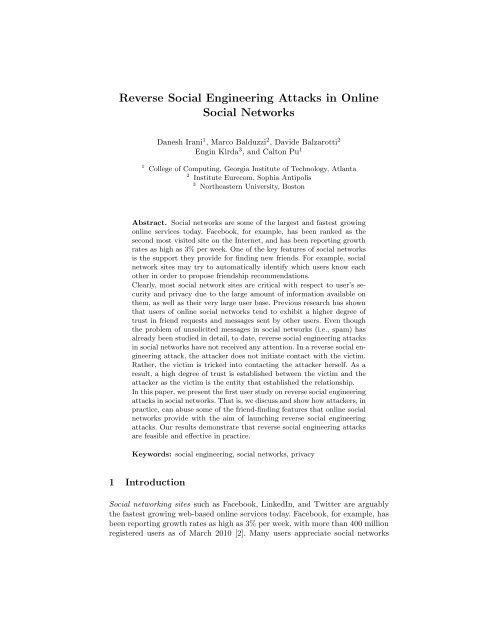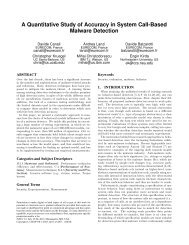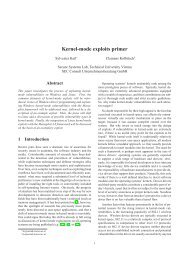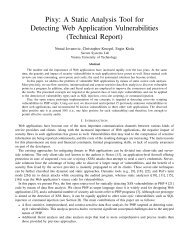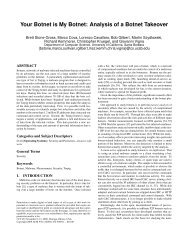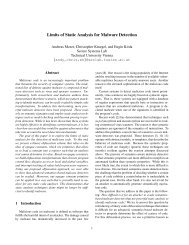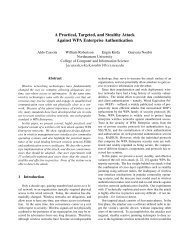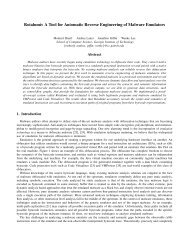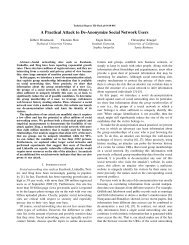Reverse Social Engineering Attacks in Online Social Networks
Reverse Social Engineering Attacks in Online Social Networks
Reverse Social Engineering Attacks in Online Social Networks
You also want an ePaper? Increase the reach of your titles
YUMPU automatically turns print PDFs into web optimized ePapers that Google loves.
<strong>Reverse</strong> <strong>Social</strong> <strong>Eng<strong>in</strong>eer<strong>in</strong>g</strong> <strong>Attacks</strong> <strong>in</strong> Onl<strong>in</strong>e<strong>Social</strong> <strong>Networks</strong>Danesh Irani 1 , Marco Balduzzi 2 , Davide Balzarotti 2Eng<strong>in</strong> Kirda 3 , and Calton Pu 11 College of Comput<strong>in</strong>g, Georgia Institute of Technology, Atlanta2 Institute Eurecom, Sophia Antipolis3 Northeastern University, BostonAbstract. <strong>Social</strong> networks are some of the largest and fastest grow<strong>in</strong>gonl<strong>in</strong>e services today. Facebook, for example, has been ranked as thesecond most visited site on the Internet, and has been report<strong>in</strong>g growthrates as high as 3% per week. One of the key features of social networksis the support they provide for f<strong>in</strong>d<strong>in</strong>g new friends. For example, socialnetwork sites may try to automatically identify which users know eachother <strong>in</strong> order to propose friendship recommendations.Clearly, most social network sites are critical with respect to user’s securityand privacy due to the large amount of <strong>in</strong>formation available onthem, as well as their very large user base. Previous research has shownthat users of onl<strong>in</strong>e social networks tend to exhibit a higher degree oftrust <strong>in</strong> friend requests and messages sent by other users. Even thoughthe problem of unsolicited messages <strong>in</strong> social networks (i.e., spam) hasalready been studied <strong>in</strong> detail, to date, reverse social eng<strong>in</strong>eer<strong>in</strong>g attacks<strong>in</strong> social networks have not received any attention. In a reverse social eng<strong>in</strong>eer<strong>in</strong>gattack, the attacker does not <strong>in</strong>itiate contact with the victim.Rather, the victim is tricked <strong>in</strong>to contact<strong>in</strong>g the attacker herself. As aresult, a high degree of trust is established between the victim and theattacker as the victim is the entity that established the relationship.In this paper, we present the first user studyon reverse social eng<strong>in</strong>eer<strong>in</strong>gattacks <strong>in</strong> social networks. That is, we discuss and show how attackers, <strong>in</strong>practice, can abuse some of the friend-f<strong>in</strong>d<strong>in</strong>g features that onl<strong>in</strong>e socialnetworks provide with the aim of launch<strong>in</strong>g reverse social eng<strong>in</strong>eer<strong>in</strong>gattacks. Our results demonstrate that reverse social eng<strong>in</strong>eer<strong>in</strong>g attacksare feasible and effective <strong>in</strong> practice.Keywords: social eng<strong>in</strong>eer<strong>in</strong>g, social networks, privacy1 Introduction<strong>Social</strong> network<strong>in</strong>g sites such as Facebook, L<strong>in</strong>kedIn, and Twitter are arguablythe fastest grow<strong>in</strong>g web-based onl<strong>in</strong>e services today. Facebook, for example, hasbeen report<strong>in</strong>g growth rates as high as 3% per week, with more than 400 millionregistered users as of March 2010 [2]. Many users appreciate social networks
ecause they make it easier to meet new people, f<strong>in</strong>d old friends, and sharemultimedia artifacts such as videos and photographs.One of the key features of social networks is the support they provide forf<strong>in</strong>d<strong>in</strong>g new friends. For example, a typical technique consists of automaticallyidentify<strong>in</strong>g common friends <strong>in</strong> cliques and then promot<strong>in</strong>g new friendships withmessages such as “You have 4 mutual friends with John Doe. Would you liketo add John Doe as a new friend?”. Also, <strong>in</strong>formation on the activities of usersare often collected, analyzed, and correlated to determ<strong>in</strong>e the probability thattwo users may know each other. If a potential acqua<strong>in</strong>tance is detected, a newfriendship recommendation might be displayed by the social network site whenthe user logs <strong>in</strong>.Clearly, social networks are critical applications with respect to the securityand privacy of their users. In fact, the large amount of <strong>in</strong>formation published,and often publicly shared, on the user profiles is <strong>in</strong>creas<strong>in</strong>gly attract<strong>in</strong>g the attentionofattackers.<strong>Attacks</strong>onsocialnetworksareusuallyvariantsoftraditionalsecurity threats (such as malware, worms, spam, and phish<strong>in</strong>g). However, theseattacks are carried out <strong>in</strong> a different context by leverag<strong>in</strong>g the social networks asa new medium to reach the victims. Moreover, adversaries can take advantageof the trust relationships between “friends” <strong>in</strong> social networks to craft more conv<strong>in</strong>c<strong>in</strong>gattacks by exploit<strong>in</strong>g personal <strong>in</strong>formation gleaned from victims’ pages.Past research has shown that users of onl<strong>in</strong>e social networks tend to exhibita higher degree of trust <strong>in</strong> friend requests and messages sent by other users(e.g., [1, 5]). In addition, some forms of attacks on social networks, such asthe problem of unsolicited messages, have already been studied <strong>in</strong> detail by theresearch community (e.g., [9, 16]). However, to date, reverse social eng<strong>in</strong>eer<strong>in</strong>gattacks <strong>in</strong> social networks have not received any attention. Hence, no previouswork exists on the topic.In a reverse social eng<strong>in</strong>eer<strong>in</strong>g attack, the attacker does not <strong>in</strong>itiate contactwith the victim. Rather, the victim is tricked <strong>in</strong>to contact<strong>in</strong>g the attacker herself.As a result, a high degree of trust is established between the victim and theattacker as the victim is the entity that first wanted to establish a relationship.Once a reversesocialeng<strong>in</strong>eer<strong>in</strong>gattackis successful(i.e., the attackerhas establisheda friend relationship with the victim), she can then launch a wide rangeof attacks such as persuad<strong>in</strong>g victims to click on malicious l<strong>in</strong>ks, blackmail<strong>in</strong>g,identity theft, and phish<strong>in</strong>g.This paper presents the first user study on how attackers can abuse some ofthe features provided by onl<strong>in</strong>e social networks with the aim of launch<strong>in</strong>g automatedreversesocialeng<strong>in</strong>eer<strong>in</strong>gattacks.We presentthreenovelattacks,namely,recommendation-based, visitor track<strong>in</strong>g-based, and demographics-based reversesocial eng<strong>in</strong>eer<strong>in</strong>g. Furthermore, us<strong>in</strong>g the popular social networks Facebook,Badoo, and Friendster, we discuss and measure the effectiveness of these attacks,and we show which social network<strong>in</strong>g features make such attacks feasible<strong>in</strong> practice.In the recommendation attack, the aim is to exploit the friend recommendationsmade by the social network to promote the fake profile of a fictitious user
to the victim. The hope, from the attacker’s po<strong>in</strong>t of view, is that the victimwill be <strong>in</strong>trigued by the recommendation, and will attempt to contact the bogusprofile that is under the attacker’s control. In the visitor track<strong>in</strong>g attack, theaim is to trigger the target’s curiosity by simply brows<strong>in</strong>g her profile page. Thenotification that the page has been visited may be enough to attract the targetto visit the attacker profile. F<strong>in</strong>ally, <strong>in</strong> the demographic-based attack scenario,the attacker attempts to reach his victims by forg<strong>in</strong>g fake demographic or personal<strong>in</strong>formation with the aim of attract<strong>in</strong>g the attention of users with similarpreferences (e.g., similar musical tastes, similar <strong>in</strong>terests, etc.).Our f<strong>in</strong>d<strong>in</strong>gs suggest that, contrary to the common folk wisdom, only hav<strong>in</strong>gan account with an attractive photograph may not be enough to recruit a highnumber of unsuspect<strong>in</strong>g victims. Rather, the attacker needs to provide victimswith a pretext and an <strong>in</strong>centive for establish<strong>in</strong>g contact.In this paper, we make the follow<strong>in</strong>g contributions:– We present the first user study on reverse social eng<strong>in</strong>eer<strong>in</strong>g <strong>in</strong> social networksand present three novel attacks. In particular, we discuss and measurehow attackers can abuse some of the friend-f<strong>in</strong>d<strong>in</strong>g features that onl<strong>in</strong>e socialnetworks provide with the aim of launch<strong>in</strong>g automated reverse socialeng<strong>in</strong>eer<strong>in</strong>g attacks aga<strong>in</strong>st victims.– We measure how different user profile attributes and friend recommendationfeatures affect the success of reverse social eng<strong>in</strong>eer<strong>in</strong>g attempts.– We study the <strong>in</strong>teractions of users with accounts that have been set up toperform reverse social eng<strong>in</strong>eer<strong>in</strong>g, and provide <strong>in</strong>sights <strong>in</strong>to why users fallvictim to such attacks.– We propose mitigation techniques to secure social networks aga<strong>in</strong>st reversesocial eng<strong>in</strong>eer<strong>in</strong>g attempts.2 <strong>Reverse</strong> <strong>Social</strong> <strong>Eng<strong>in</strong>eer<strong>in</strong>g</strong> <strong>in</strong> <strong>Social</strong> <strong>Networks</strong>Onl<strong>in</strong>e social eng<strong>in</strong>eer<strong>in</strong>g attacks are easy to propagate, difficult to trace backto the attacker, and usually <strong>in</strong>volves a low cost per targeted user. They arewell-known threats <strong>in</strong> which the attacker aims at <strong>in</strong>fluenc<strong>in</strong>g the victims, andmak<strong>in</strong>g them perform actions on her behalf. The attacker is typically <strong>in</strong>terested<strong>in</strong> trick<strong>in</strong>g the victims <strong>in</strong>to reveal<strong>in</strong>g sensitive or important <strong>in</strong>formation. Examplesof these attacks <strong>in</strong>clude traditional e-mail hoaxes and phish<strong>in</strong>g, or theirmore advanced targeted forms, such as spear phish<strong>in</strong>g.Most onl<strong>in</strong>e social eng<strong>in</strong>eer<strong>in</strong>gattacks rely on some form of“pretext<strong>in</strong>g” [14].That is, the attacker establishes contact with the target, and sends some <strong>in</strong>itialrequest to bootstrap the attack. This approach, although effective because itcan reach a large number of potential victims, has the downside that Internetusersarebecom<strong>in</strong>g moreand moresuspicious aboutunsolicited contactrequests.However, previous work has shown that it is possible to raise levels of trust byimpersonat<strong>in</strong>g an exist<strong>in</strong>g friend of the target (e.g., [5, 10]) or by <strong>in</strong>ject<strong>in</strong>g theattack <strong>in</strong>to exist<strong>in</strong>g chat conversations [13].
¢£¤¥¦ ¡ ¢ ¢¤¥ ¦§¥¨©§§¥£¥¢¥ .//012340 9023 :4;97
– Targeted/Un-targeted: In a targeted attack, the attacker focuses on a particularuser. In contrast, <strong>in</strong> an un-targeted attack, the attacker is solely<strong>in</strong>terested <strong>in</strong> reach<strong>in</strong>g as many users as possible. Note that <strong>in</strong> order to performa targeted attack, the attacker has to know (or acquire) some previous<strong>in</strong>formation about the target (e.g., such as her username or e-mail address).– Direct/Mediated: In a direct attack, the bait<strong>in</strong>g action of the attacker is visibleto the targeted users. For example, an attacker can post a message ona public forum, or publish some <strong>in</strong>terest<strong>in</strong>g picture on a website. Mediatedattacks, <strong>in</strong> contrast, follow a two-step approach <strong>in</strong> which the bait<strong>in</strong>g is collectedby an <strong>in</strong>termediate agent that is then responsible for propagat<strong>in</strong>g it(often <strong>in</strong> a different form) to the targeted users.In the follow<strong>in</strong>g, we present three different comb<strong>in</strong>ations of RSE attackswith<strong>in</strong> the context of onl<strong>in</strong>e social networks.Recommendation-Based RSE [Targeted, Mediated] Recommendation systems<strong>in</strong> social networks propose relationships between users based on background,or “secondary knowledge” on users. This knowledge derives from the<strong>in</strong>teractionsbetween registeredusers,the friend relationshipsbetween them, andother artifacts based on their <strong>in</strong>teraction with the social network. For example,the social network<strong>in</strong>g site might record the fact that a user has visited a certa<strong>in</strong>profile, a page, a picture, and also log the search terms she has entered. Popularsocial networks (e.g., Facebook) often use this <strong>in</strong>formation to make recommendationsto users (e.g., “Visit page X”, “You might know person Y, click here tobecome her friends”, etc.).From an attacker’s po<strong>in</strong>t of view, a recommendation system is an <strong>in</strong>terest<strong>in</strong>gtarget. If the attacker is able to <strong>in</strong>fluence the recommendation system andmake the social network issue targeted recommendations, she may be able totrick victims <strong>in</strong>to contact<strong>in</strong>g her. Figure 1(a) demonstrates the recommendationsystem-based RSE attack scenario.Demographic-Based RSE [Un-targeted, Mediated] Demographic-basedsystems<strong>in</strong> social networks allow establish<strong>in</strong>g friendships based on the <strong>in</strong>formation<strong>in</strong> a person’s profile. Some social networks, especially dat<strong>in</strong>g sites (e.g., Badoo),use this technique as the norm for connect<strong>in</strong>g users <strong>in</strong> the same geographical location,<strong>in</strong> the same age group, or those who have expressed similar preferences.Figure 1(b) demonstrates an RSE attack that uses demographic <strong>in</strong>formation.In the attack, the attacker simply creates a profile (or a number of profiles) thatwould have a high probability of appeal<strong>in</strong>g to certa<strong>in</strong> users, and then waits forvictims to <strong>in</strong>itiate contact.Visitor Track<strong>in</strong>g-Based RSE [Targeted, Direct] Visitor track<strong>in</strong>gis afeatureprovided by some social networks (e.g., X<strong>in</strong>g, Friendster) to allow users to trackwho has visited their onl<strong>in</strong>e profiles.
Type of Attack Facebook Badoo FriendsterRecommendation-Based ̌✠ - -Demographic- Based ̌ ̌✠ ̌Visitor Track<strong>in</strong>g-Based - ̌ ̌✠Table 1. RSE attacks on three popular social networks. ̌ <strong>in</strong>dicates that the attack ispossible; ✠ <strong>in</strong>dicates that we demonstrate and measure the effectiveness of this attackon the particular social network.The attack <strong>in</strong> this case <strong>in</strong>volves exploit<strong>in</strong>g the user’s curiosity by visit<strong>in</strong>gtheir profile page. The notification that the page has been visited might raise<strong>in</strong>terest, bait<strong>in</strong>g the user to view the attacker’s profile and perhaps take someaction. Figure 1(c) outl<strong>in</strong>es this attack method.3 RSE <strong>Attacks</strong> <strong>in</strong> the Real-WorldIn thissection, wepresentthree typesofreal-worldRSEattacksthat arepossibleon three different social network platforms: Facebook, Badoo, and Friendster.In particular, we describe a recommendation-based RSE attack on Facebook,a demographic-based RSE attack on Badoo, and a visitor track<strong>in</strong>g-based RSEattack on Friendster.Table1showsthe socialnetworksthat wereused<strong>in</strong> ourexperiments,andalsodescribes which k<strong>in</strong>d of RSE attacks are possible aga<strong>in</strong>st them. Note that notall the comb<strong>in</strong>ations are possible <strong>in</strong> practice. For example, Facebook does notprovide any <strong>in</strong>formation about the users that visit a certa<strong>in</strong> profile, thus mak<strong>in</strong>ga visitor track<strong>in</strong>g attack <strong>in</strong>feasible. In the rest of this section, we describe thedifferent steps that are required to automate the attacks, and the setup of theexperiments we performed.3.1 Ethical and Legal ConsiderationsReal-worldexperiments <strong>in</strong>volv<strong>in</strong>gsocialnetworksmay be consideredan ethicallysensitive area. Clearly, one question that arises is if it is ethically acceptableand justifiable to conduct experiments that <strong>in</strong>volve real users. Similar to theexperiments conducted by Jakobsson et al. [11, 12] and our previous work [5],webelievethat realisticexperimentsarethe onlywaytoreliablyestimatesuccessrates of attacks <strong>in</strong> the real-world.Furthermore, dur<strong>in</strong>g all the experiments we describe <strong>in</strong> the paper, we took<strong>in</strong>to account the privacy ofthe users, and the sensitivity of the data that was collected.When the data was analyzed, identifiers (e.g., names) were anonymized,and no manual <strong>in</strong>spection of the collected data was performed.Note that all the experiments described <strong>in</strong> the paper were performed <strong>in</strong> Europe.Hence, we consulted with the legal department of our <strong>in</strong>stitution (comparableto the Institute Review Board (IRB) <strong>in</strong> the US) and our handl<strong>in</strong>g and
privacy precautions were deemed appropriate and consistent with the Europeanlegal position.3.2 Influenc<strong>in</strong>g Friend RecommendationsA good example of a real recommendation system is Facebook’s friend suggestions.Dur<strong>in</strong>g our tests with Facebook, we observed that Facebook promotesthe connection of users by suggest<strong>in</strong>g them friends that they probably know.The system computes these suggestions based on common <strong>in</strong>formation, such asmutual friends, schools, companies, and <strong>in</strong>terests. This feature is well-known tomany social network users. In fact, whenever a user is logged <strong>in</strong>, she is regularlynotified of persons that she may know.Previous work [4] has shown that Facebook also uses the e-mail addresses auser has queried to identify a possible friendship connection between two users.The premise is that if users know each other’s e-mail addresses, they must beconnected <strong>in</strong> some way. Therefore, if an attacker ga<strong>in</strong>s access to the e-mail addressof a victim (e.g., a spammer who has a list of e-mails at her disposal), bysearch<strong>in</strong>g for that address, she can have a fake attacker profile be recommendedto the victims. In our experiments, we observed that this technique results <strong>in</strong>the attacker profile be<strong>in</strong>g the most highly recommended profile.For the first experiment, we used the data collected for over a year <strong>in</strong> apreviousstudy we performed on Facebook[4]. In the study, we registeredas<strong>in</strong>gleaccount that we used to perform a large number of e-mail search queries, us<strong>in</strong>gan email list obta<strong>in</strong>ed from a dropzone on a mach<strong>in</strong>e compromised by attackers.Without our knowledge, our profile was later recommended to all the queriedusers as a potential friend. As a result, our test account received thousands ofmessages and friend requests.3.3 Measur<strong>in</strong>g RSE Effects by Creat<strong>in</strong>g Attack ProfilesIn the second set of experiments, we created five different attack profiles <strong>in</strong>three social networks. The profiles were designed with different characteristicsto enable us to observe and measure the effects that each characteristic had onthe effectiveness of the RSE attacks. That is, we were <strong>in</strong>terested <strong>in</strong> determ<strong>in</strong><strong>in</strong>gwhich features would attract the higher number of potential victims us<strong>in</strong>g therecommendation-based, demographic-based, and visitor track<strong>in</strong>g attacks.The five attack profiles areshown <strong>in</strong> Table 2. For the profile pictures, we usedpopular photographs from Wikipedia, licensed under the Creative Commonslicense. All photos represented an attractive male or female, with the exceptionof Profile 5 for which we used a synthetic cartoon picture.Table 3 shows the number of users we targeted <strong>in</strong> the social networks wetested. For example, <strong>in</strong> the Facebook experiment, we targeted a total of 250,000profiles, equally divided between the 5 attack profiles. In the demographic-basedattack on Badoo, no action was required on behalf of the attacker. Hence, thenumber of targeted users is not given (i.e., all registered Badoo users could havefound and contacted the attacker profile).
Attribute Prof. 1 Prof. 2 Prof. 3 Prof. 4 Prof. 5Age 23 23 23 35 23Sex Male Female Female Female FemaleLocation* N.Y. N.Y. Paris N.Y. N.Y.Real Picture Yes Yes Yes Yes NoTable 2. Characteristics of the dummy profiles used <strong>in</strong> the experiments. (* In Badoo,more popular <strong>in</strong> Europe, we replaced N.Y with London)<strong>Social</strong> Network # of Targets Total users Alexia RankBadoo - 73 million 143Facebook 250,000 500 million 2Friendster 42,000 8.2 million 643Table 3. Overview of OSNs as well as number of users targeted.3.4 Automat<strong>in</strong>g the Measurement ProcessDur<strong>in</strong>gourstudy wedevelopedanumberofscriptstoautomatethethreeattacksand the measurement process on the different social networks.Recommendation-Based RSE on Facebook As shown <strong>in</strong> Figure 1(a), therecommendation-based RSE attack aga<strong>in</strong>st Facebook consisted of two parts:First, the target user’s profile was probed us<strong>in</strong>g an e-mail lookup, and second,the attack accounts were automatically monitored for victims who contactedthese accounts based on the friendship recommendation made by Facebook.For the first part, we used the “contact import” functionality provided byFacebook and the API provided by Google Mail’s address book to automaticallysearch for users by their e-mail addresses. We broke the total set of users wewished to query <strong>in</strong>to smaller sets, and sent multiple requests to Facebook, asthey have limited the number of e-mail addresses that can be queried us<strong>in</strong>g as<strong>in</strong>gle request (because of recommendations made <strong>in</strong> previous work [4]).In the second part of the experiments, we wrote an API that allowed us to<strong>in</strong>teract with Facebook to accept friend requests, fetch user profiles, as well asfetch any private message that may have been sent to the attack profiles.Note that CAPTCHAs <strong>in</strong> Facebook were only encountered if we were notcareful about rate limit<strong>in</strong>g.Demographic-Based RSEon Badoo WeusedBadoototestthedemographicbasedRSE attack. Hence, we only had to create the attack profiles and automaticallymonitor <strong>in</strong>com<strong>in</strong>g connections. Just like <strong>in</strong> the recommendation-basedRSE attack, we automatically retrieved and collected any message sent to theattacker profiles. Furthermore, as Badoo allows to see which users have visiteda profile, we also logged this <strong>in</strong>formation.
Number of daily friend requests1401201008060402002010-042010-032010-022010-012009-122009-112009-102009-092009-082009-07Fig.2. Daily number of new friend requests <strong>in</strong> the <strong>in</strong>itial Facebook experimentVisitor Track<strong>in</strong>g-Based RSE on Friendster We used Friendster to performthe RSE attack based on visitor track<strong>in</strong>g. As shown <strong>in</strong> Figure 1(c), this attackconsistsoftwoparts:First,wevisitthetargetuser’sprofileandasaconsequence,the system shows to the victim that someone has visited her profile. If theattacker profile is <strong>in</strong>terest<strong>in</strong>g, the victim may choose to contact the attacker.Hence, <strong>in</strong> a second step, the visits and the <strong>in</strong>com<strong>in</strong>g messages to the attackprofiles were automatically monitored to determ<strong>in</strong>e which of the victims cameback and <strong>in</strong>itiated contact.4 Experimental Results4.1 Recommendation-based RSE AttackInitial Experiment Dur<strong>in</strong>g the study [4] we conducted, we observed that thetest account we were us<strong>in</strong>g to query e-mail addresses were receiv<strong>in</strong>g a largenumber of friend requests. The profile used <strong>in</strong> this attack was similar to Profile2 described <strong>in</strong> Table 2.Figure 2 shows the number of daily friend requests received by the accountused<strong>in</strong>this<strong>in</strong>itialexperiment.Thegraphshowsthatdur<strong>in</strong>gthefirsttwomonths,the account received an average of 45 requests per day, followed by an <strong>in</strong>creaseto an average of 75 requests per day for the next 6 months.The rapid <strong>in</strong>crease <strong>in</strong> the number of request is the consequence of the cascad<strong>in</strong>geffect that commenced when we started accept<strong>in</strong>g the <strong>in</strong>com<strong>in</strong>g <strong>in</strong>vitations.The fact that the account had a large number of friends built up the “reputation”of our profile. In addition, we started be<strong>in</strong>g advertised by Facebook to newpeople with whom we shared common friends.Of the over 500,000 e-mails queried by our decoy profile, we were contactedby over 17,000 users (i.e., 3.3% friend connect rate with<strong>in</strong> 9 months and 0.37%friend connect rate per month). Note that our test account reached both themaximum number of active friend connections and the total number of pend<strong>in</strong>gfriend requests allowed by Facebook.
Controlled, In-Depth Experiments After the success of the <strong>in</strong>itial experiment,we started a number of controlled, <strong>in</strong>-depth experiments to measure anddeterm<strong>in</strong>e which profile characteristics and social network features affect thesuccess rates of RSE attacks.To reach our goal, we created five attack profiles on Facebook. For eachprofile, we randomly selected 50,000 target users and looked up their e-mailaddresses(hence, <strong>in</strong>fluenc<strong>in</strong>g the recommendationsmade by Facebook). We thenmeasured the number of friend-requests, private messages, and other <strong>in</strong>teractionsent to each attack profile. Figure 3 depicts the result of this experiment. They-axis represents the cumulative number of friend requests or messages for theperiod represented by the date on the x-axis.Profiles 2 and 3 were the most successful <strong>in</strong> terms of the number of friendrequests and messages that were received. Both profiles correspond to attractivefemales who are <strong>in</strong>terested <strong>in</strong> friendship. Note that there was no correlationwith the location of the attack profile (i.e., the location did not <strong>in</strong>fluence friendrequests). Hence, an <strong>in</strong>itial analysis seems to confirm the general <strong>in</strong>tuition thatan attractive female photograph will attract potential victims. In contrast tothe other profiles, Profile 5 was the least effective. In this profile, a cartooncharacter was used as a photograph rather than a real picture. In comparison,Profile 1 performed only slightly better than Profile 5. This profile conta<strong>in</strong>ed thephotograph of an attractive male.Over the entire month, the most effective profile had a friend connection rateof 0.35% (i.e., <strong>in</strong> l<strong>in</strong>e with the <strong>in</strong>itial experimental profile). The least effectiveprofile <strong>in</strong>stead, had a friend connection rate of only 0.05%.Although friend connection requests and private messages were the mostcommon form of <strong>in</strong>teractionwith a decoyprofile, we also receivedalargenumberof friend suggestions. Friend suggestions are suggestions made by the victim toother users. Such suggestions are important as they imply that a high level oftrust hasbeen achievedbetweenthe attackerand the victim. Also,notethat over94% of the messages to the attack profiles were sent after the friend connectionrequests.By analyz<strong>in</strong>g the demography of the users who contacted our attack profiles,we can identify potential characteristics that make a decoy profile appeal<strong>in</strong>g. Inparticular, we focused on three fields: relationship status, <strong>in</strong>terested <strong>in</strong>, and age(Figure 4). The y-axis of the figure shows the percentage of friend connectionrequests that orig<strong>in</strong>ated from a profile with the respective demographic value(empty values excluded) to the attack profile listed on the x-axis. Young, s<strong>in</strong>gleusers who have expressed <strong>in</strong>terest <strong>in</strong> “Women” seem to be the easiest victims toattract. In comparison, Profile 1 (the only male profile) received a larger numberof friend requests from users who had expressed <strong>in</strong>terest <strong>in</strong> “Men”.Interest<strong>in</strong>gly, the profile with a cartoon picture was the one to attract thelargest number of requests com<strong>in</strong>g from older users (i.e., those who were olderthan 40). Hence, the experiments show that by carefully tweak<strong>in</strong>g the profile<strong>in</strong>formation, it is possible to obta<strong>in</strong> an higher success rate aga<strong>in</strong>st a particulargroup of users.
1001008080Percentage (%)604020Percentage (%)60402000Profile 1Profile 2Profile 3Profile 4Profile 5Profile 1Profile 2Profile 3Profile 4Profile 5S<strong>in</strong>gleOpen relationshipTaken(a) Relationship StatusMen Women Women Men(b) Interested In10080Percentage (%)6040200Profile 1Profile 2Profile 3Profile 4Profile 560Fig.6. Demographic breakdown by Relationship Status, Interested In, and Age formessages on Badoo.4.3 Visitor Track<strong>in</strong>g ExperimentIn the visitor track<strong>in</strong>g RSE attack, we used each of the five attack profiles tovisit 8,400 different user profiles <strong>in</strong> Friendster. As we have already previouslydescribed, on Friendster a user can check which other users have visited herprofile.In our experiment, we tracked which victims visited our attack profiles, andthen counted the number of users who sent us a friend request. The results ofthis experiment are shown <strong>in</strong> Figure 7 (the sub-figure 7(a) and 7(b) representthe number of visitors and number of friend requests sent to the attack profiles).The number of users who were curious about our visit, and visited us backwas consistent with the results of the experiments we conducted on other socialnetworks (i.e., between 0.25 and 1.2% per month). However, only a few userslater sent a friend request or a message.The demographic breakdown for Friendster is presented <strong>in</strong> Figure 4.3. Thestatistical distributions are similar to the ones obta<strong>in</strong>ed <strong>in</strong> the Facebook experiment,prov<strong>in</strong>g the difference <strong>in</strong> terms of characteristics between friend-orientedand dat<strong>in</strong>g-oriented social networks.
Number of visitors140120100806040Profile 1Profile 2Profile 3Profile 4Profile 520008/2108/1408/0707/3107/24(a) Visitors to each profileNumber of friend requests181614121086420Profile 1Profile 2Profile 3Profile 4Profile 509/1109/0408/2808/2108/1408/0707/3107/2410/0910/0209/2509/1809/1109/0408/2810/0910/0209/2509/18(b) Friend requests sent to each profileFig.7. Cumulative counts of <strong>in</strong>teractions result<strong>in</strong>g from reverse social eng<strong>in</strong>eer<strong>in</strong>g onFriendster.5 Discussion and Lessons LearnedIn this section, based on the results of the empirical experiments, we distill some<strong>in</strong>sights about the way RSE attacks work <strong>in</strong> social networks. We can summarizeour f<strong>in</strong>d<strong>in</strong>gs <strong>in</strong> two ma<strong>in</strong> po<strong>in</strong>ts: The importance of hav<strong>in</strong>g the right profile, andthe importance of provid<strong>in</strong>g a pretext to the victims.The first, straightforward,factorwe were able to measure is the impact of theprofile characteristics on the overall effectiveness of an attack. The experimentsconfirm the folk wisdom that us<strong>in</strong>g an attractive female photograph is a goodchoice to attract victims. The success rate of the most successful female profile,<strong>in</strong> terms of both friend requests and number of received messages, is between2 and 40 times higher than the worse perform<strong>in</strong>g profiles (i.e., the male profileand the profile without a photograph).Note that if the objective of the attack is not simply to reach the highestnumber of users, but to target a specific person, or group, the success rate of the
1001008080Percentage (%)6040Percentage (%)6040202000Profile 1Profile 2Profile 3Profile 4Profile 5Profile 1Profile 2Profile 3Profile 4Profile 5S<strong>in</strong>gleIn a RelationshipIt’s ComplicatedMarried(a) Relationship StatusMen(b) Interested InWomen10080Percentage (%)6040200Profile 1Profile 2Profile 3Profile 4Profile 560attack can be improved by carefully tun<strong>in</strong>g the profile characteristics. For example,our experiments show that age and location <strong>in</strong>formation are decisive <strong>in</strong> dat<strong>in</strong>gsites, while this <strong>in</strong>formation is not as critical <strong>in</strong> more general,friend-oriented,social networks. Also, the results suggest that gender <strong>in</strong>formation is always veryimportant. Hence, a successful reverse social eng<strong>in</strong>eer<strong>in</strong>g attack should use theopposite sex of the victims <strong>in</strong> the decoy profile.The experiments show that the impact of the profile picture is quite uniform<strong>in</strong> different social networks. For example, we observe that young users are generallymore <strong>in</strong>trigued by attractive photographs, while decoy profiles (e.g., Profile5) that do not conta<strong>in</strong> the photograph of a real person tend to attract moresenior users.Obviously, even though hav<strong>in</strong>g a catchy, <strong>in</strong>terest<strong>in</strong>g profile is important, ourresearch shows that there is a second, even more important factor that contributesto the success of the attack: the pretext. Our experiments <strong>in</strong>dicate thatusers need an <strong>in</strong>centive and a good reason to engage <strong>in</strong> <strong>in</strong>teraction with a personthat they do not know. In other words, users need a good excuse to “break theice” and motivate the first approach. The differences between the success ratesof the attacks on Facebook and Friendster suggest that an <strong>in</strong>centive or a pretextis critical for reverse social eng<strong>in</strong>eer<strong>in</strong>g attacks to work <strong>in</strong> practice.The analysis of the messages received on Facebook support the hypothesisthat a recommendation system gives a reason to users to <strong>in</strong>itiate contact. Thatis, a number of users referenced the Facebook recommendation as a motivation
for their friend request. In contrast, on Friendster, even though the percentageof users that browsed our decoy profiles was consistent with the other socialnetwork experiments, very few people moved to the next step and sent a contactmessage. The reason is, <strong>in</strong> our op<strong>in</strong>ion, that the visitor track<strong>in</strong>g attack failed toprovide a good pretext to the victims.Note that the demographic experiment on Badoo was also very effective. Thereason for this success is that Badoo greatly relies on the demographic searchfunctionality to allow users to f<strong>in</strong>d possible contacts. In the case of a dat<strong>in</strong>g site,the pretext for establish<strong>in</strong>gcontact wasthe fact itself ofliv<strong>in</strong>g <strong>in</strong> a close location,or be<strong>in</strong>g <strong>in</strong> the same age group of the victim.Our experiments demonstrate that reverse social eng<strong>in</strong>eer<strong>in</strong>g attacks on socialnetworks are feasible if they are properly designed and executed. However,contrary to the common folk wisdom, only hav<strong>in</strong>g an account with an attractivephotographmaynotbe enoughtorecruitahighnumberofunsuspect<strong>in</strong>g victims.Rather, the attacker needs to comb<strong>in</strong>e an attractive profile with a pretext and<strong>in</strong>centive for the victim to establish contact. Recommendation systems such asFacebook’s friend suggestions are effective tools for creat<strong>in</strong>g such an <strong>in</strong>centive.Also, we see that profile attributes such as location and age may be the required<strong>in</strong>centives on dat<strong>in</strong>g networks such as Badoo.6 RSE Countermeasures <strong>in</strong> OSNClearly, features that allow social network users to easily make new acqua<strong>in</strong>tancesare useful <strong>in</strong> practice. However, our paper demonstrates that such systemsmay also be abused to trick users on behalf of attackers. In this section, welist three countermeasures that would <strong>in</strong>crease the difficulty of launch<strong>in</strong>g RSEattacks <strong>in</strong> onl<strong>in</strong>e social networks.First, while friend recommendation features are useful, our experiments showthat they may pose a risk to users if the attackers are able to somehow <strong>in</strong>fluencethe recommendation system. Hence, it is important for social network providersto show a potential connection between two users only if there is a strong connectionbetween them. For example, <strong>in</strong> the case of Facebook, as our experimentsshow, a simple e-mail lookup does not necessarily <strong>in</strong>dicate that the users knoweach other. Thus, one could check other <strong>in</strong>formation, such as the fact that theusers already have some friends <strong>in</strong> common.Second, we believe that it is important to closely monitor friendships thathavebeen established<strong>in</strong> socialnetworks.Benignuseraccountswilltypicallysendand receive friend requests <strong>in</strong> both directions. That is, a user may be contactedby people she knows, but she will also actively search and add friends on thenetwork. However, <strong>in</strong> contrast, a honeypot RSE account (as we describe <strong>in</strong> thispaper) only receives friend requests from other users. Thus, it may be possibleto identify such accounts automatically.Third, we believe that CAPTCHA usage also needs to be extended to <strong>in</strong>com<strong>in</strong>gfriend requests. Today, because of the active threats of spamm<strong>in</strong>g and social
eng<strong>in</strong>eer<strong>in</strong>g, social network providers may display CAPTCHAs when friend requestsare sent to other users. However, no such precautions are taken for messagesand friend requests that are received. By requir<strong>in</strong>g to solve a CAPTCHAchallenge before be<strong>in</strong>g able to accept suspicious <strong>in</strong>com<strong>in</strong>g friend requests, we believethat RSE attacks would become more difficult. While CAPTCHAs are notthe silver bullet <strong>in</strong> prevent<strong>in</strong>g and stopp<strong>in</strong>g malicious activity on social networks(e.g., as show <strong>in</strong> [1, 5]), they do raise the difficulty bar for the attackers.7 Related Work<strong>Social</strong> eng<strong>in</strong>eer<strong>in</strong>g attacks are well-known <strong>in</strong> practice as well as <strong>in</strong> literature(e.g., [14, 3, 17, 8, 16]). <strong>Social</strong> eng<strong>in</strong>eer<strong>in</strong>g targets human weaknesses <strong>in</strong>steadof vulnerabilities <strong>in</strong> technical systems. Automated <strong>Social</strong> <strong>Eng<strong>in</strong>eer<strong>in</strong>g</strong> (ASE) isthe process of automatically execut<strong>in</strong>g social eng<strong>in</strong>eer<strong>in</strong>g attacks. For example,spamm<strong>in</strong>g and phish<strong>in</strong>g can be seen as a very simple form of social eng<strong>in</strong>eer<strong>in</strong>g(i.e., mak<strong>in</strong>g users click on l<strong>in</strong>ks).A general problem on social networks is that it is difficult for users to judgeif a friend request is trustworthy or not. Thus, users are often quick <strong>in</strong> accept<strong>in</strong>g<strong>in</strong>vitationsfrompeopletheydonotknow.Forexample,anexperimentconductedby Sophos <strong>in</strong> 2007 showed that 41% of Facebook users acknowledged a friendrequest from a randomperson[1]. Morecautions userscan be trickedby requestsfrom adversaries that impersonate friends [5]. Unfortunately, once a connectionis established, the attacker typically has full access to all <strong>in</strong>formation on thevictim’s profile. Moreover, users who receive messages from alleged friends aremuch more likely to act upon such message, for example, by click<strong>in</strong>g on l<strong>in</strong>ks. AsimilarresultwasreportedbyJagaticetal.[10].Theauthorsfoundthatphish<strong>in</strong>gattempts are more likely to succeed if the attacker uses stolen <strong>in</strong>formation fromvictims’ friends <strong>in</strong> social networks to craft their phish<strong>in</strong>g e-mails.In contrast to active social eng<strong>in</strong>eer<strong>in</strong>g that requires the attacker to establishcontact with the victim, <strong>in</strong> a reverse social eng<strong>in</strong>eer<strong>in</strong>g attack, it is the victimthat contacts the attacker. We are not aware of any previous reports or studieson reverse social eng<strong>in</strong>eer<strong>in</strong>g attacks <strong>in</strong> onl<strong>in</strong>e social networks. The results ofthis paper demonstrate that automated reverse social eng<strong>in</strong>eer<strong>in</strong>g is a realisticthreat, and that it is feasible <strong>in</strong> practice.The most well-known attack to compromise the trust relationship <strong>in</strong> a socialnetwork that employs a reputation system is the sybil attack [6]. In this attack,the attacker creates multiple fake identities and use them to ga<strong>in</strong> a disproportionatelylarge <strong>in</strong>fluence on the reputation system. Note that the f<strong>in</strong>d<strong>in</strong>gs <strong>in</strong> thispaper have implications for research that aims to defend social networks aga<strong>in</strong>stsybil attacks (e.g., SybilGuard [18], SybilLimit [19]). SybilGuard and SybilLimitassume that real-world social networks are fast mix<strong>in</strong>g [7] and this <strong>in</strong>sight isused to dist<strong>in</strong>guish the sybil nodes from normal nodes. Fast mix<strong>in</strong>g means thatsubsets of honest nodes have good connectivity to the rest of the social network.Both SybilGuard and SybilLimit are good solutions for detect<strong>in</strong>g Sybilnodes. However, the attacks we present <strong>in</strong> this paper result <strong>in</strong> legitimate friend-
ship connections and, therefore,wouldnot be detected by currentsybil-detectionapproaches.8 ConclusionHundreds of millions of users are registered to social network<strong>in</strong>g sites and regularlyuse them features to stay <strong>in</strong> touch with friends, communicate, do onl<strong>in</strong>ecommerce, and share multimedia artifacts with other users.To be able to make suggestionsand to promotefriendships, social network<strong>in</strong>gsites often m<strong>in</strong>e the data that has been collected about the registered users. Forexample, the fact that a user looks up an e-mail address might be assumed to<strong>in</strong>dicate that the user knows the person who owns that e-mail account. Unfortunately,such assumptions can also be abused by attackers to <strong>in</strong>fluence recommendations,or to <strong>in</strong>crease the chance that the victim’s <strong>in</strong>terest is <strong>in</strong>trigued bya fake honey-account.Although socialeng<strong>in</strong>eer<strong>in</strong>g attacks<strong>in</strong> social networkshavebeen well-studiedtodate,reverse social eng<strong>in</strong>eer<strong>in</strong>g(RSE)attackshavenotreceivedanyattention.This paper presents the first user study on how attackers can abuse someof the features provided by onl<strong>in</strong>e social networks with the aim of launch<strong>in</strong>gautomated reverse social eng<strong>in</strong>eer<strong>in</strong>g attacks. We present and study the effectivenessand feasibility of three novel attacks: Recommendation-based, visitortrack<strong>in</strong>g-based, and demographic-based reverse social eng<strong>in</strong>eer<strong>in</strong>g.Our results show that RSE attacks are a feasible threat <strong>in</strong> real-life, andthat attackers may be able to attract a large numbers of legitimate users withoutactively send<strong>in</strong>g any friend request. The experiments we have conducteddemonstrate that suggestions and friend-f<strong>in</strong>d<strong>in</strong>g features (e.g., demographicbasedsearches) made by social network<strong>in</strong>g sites may provide an <strong>in</strong>centive forthe victims to contact a user if the right sett<strong>in</strong>g is created (e.g., an attractivephotograph, an attack profile with similar <strong>in</strong>terests, etc.).We hope that this paper will raise awareness about the real-world threat ofreverse social eng<strong>in</strong>eer<strong>in</strong>g <strong>in</strong> social networks and will encourage social networkproviders to adopt some countermeasures.Acknowledgments. The research lead<strong>in</strong>g to these results has received fund<strong>in</strong>gfrom the European Union Seventh Framework Programme (FP7/2007-2013)under grant agreement n o 257007. This research has been partially funded byNational Science Foundation by IUCRC, CyberTrust, CISE/CRI, and NetSEprograms, National Center for Research Resources, and gifts, grants, or contractsfrom Wipro Technologies, Fujitsu Labs, Amazon Web Services <strong>in</strong> Educationprogram, and Georgia Tech Foundation through the John P. Imlay, Jr.Chair endowment. Any op<strong>in</strong>ions, f<strong>in</strong>d<strong>in</strong>gs, and conclusions or recommendationsexpressed <strong>in</strong> this material are those of the author(s) and do not necessarily reflectthe views of the National Science Foundation or other fund<strong>in</strong>g agencies andcompanies mentioned above.
References[1] Sophos Facebook ID Probe. http://www.sophos.com/pressoffice/news/articles/2007/08/facebook.html, 2008.[2] Facebook Statistics. http://www.facebook.com/press/<strong>in</strong>fo.php?statistics,2010.[3] Sophos Security Threat 2010. http://www.sophos.com/sophos/docs/eng/papers/sophos-security-threat-report-jan-2010-wpna.pdf, 2010.[4] Balduzzi, M., Platzer, C., Holz, T., Kirda, E., Balzarotti, D., andKruegel, C. Abus<strong>in</strong>g <strong>Social</strong> <strong>Networks</strong> for Automated User Profil<strong>in</strong>g. In RecentAdvances <strong>in</strong> Intrusion Detection (2010), Spr<strong>in</strong>ger, pp. 422–441.[5] Bilge, L., Strufe, T., Balzarotti, D., and Kirda, E. All Your ContactsAre Belong to Us: Automated Identity Theft <strong>Attacks</strong> on <strong>Social</strong> <strong>Networks</strong>. In 18thInternational Conference on World Wide Web (WWW) (2009).[6] Douceur, J. R. The Sybil Attack. In Electronic Proceed<strong>in</strong>gs for the 1st InternationalWorkshop on Peer-to-Peer Systems (IPTPS ’02) (March 2002).[7] Flaxman, A. Expansion and lack thereof <strong>in</strong> randomly perturbed graphs. InternetMathematics 4, 2 (2007), 131–147.[8] Irani, D., Webb, S., Giff<strong>in</strong>, J., and Pu, C. Evolutionary study of phish<strong>in</strong>g.In eCrime Researchers Summit, 2008 (2008), IEEE, pp. 1–10.[9] Irani, D., Webb, S., Pu, C., and Li, K. Study of Trend-Stuff<strong>in</strong>g on Twitterthrough Text Classification. In Collaboration, Electronic messag<strong>in</strong>g, Anti-Abuseand Spam Conference (CEAS) (2010).[10] Jagatic, T. N., Johnson, N. A., Jakobsson, M., and Menczer, F. <strong>Social</strong>phish<strong>in</strong>g. Commun. ACM 50, 10 (2007), 94–100.[11] Jakobsson, M., F<strong>in</strong>n, P., and Johnson, N. Why and How to Perform FraudExperiments. Security & Privacy, IEEE 6, 2 (March-April 2008), 66–68.[12] Jakobsson, M., and Ratkiewicz, J. Design<strong>in</strong>g ethical phish<strong>in</strong>g experiments:a study of (ROT13) rOnl query features. In 15th International Conference onWorld Wide Web (WWW) (2006).[13] Lau<strong>in</strong>ger, T., Pankakoski, V., Balzarotti, D., and Kirda, E. Honeybot,your man <strong>in</strong> the middle for automated social eng<strong>in</strong>eer<strong>in</strong>g. In LEET’10,3rd USENIX Workshop on Large-Scale Exploits and Emergent Threats, San Jose(2010).[14] Mitnick, K., Simon, W. L., and Wozniak, S. The Art of Deception: Controll<strong>in</strong>gthe Human Element of Security. Wiley, 2002.[15] Porter, M. An algorithm for suffix stripp<strong>in</strong>g. Program 14, 3 (1980), 130–137.[16] Str<strong>in</strong>gh<strong>in</strong>i, G., Kruegel, C., and Vigna, G. Detect<strong>in</strong>g Spammers on <strong>Social</strong><strong>Networks</strong>. In Annual Computer Security Applications Conference (ACSAC)(2010).[17] Webb, S., Caverlee, J., and Pu, C. <strong>Social</strong> Honeypots: Mak<strong>in</strong>g Friends with aSpammer Near You. In Conference on Email and Anti-Spam (CEAS) (2008).[18] Yu, H., Kam<strong>in</strong>sky, M., Gibbons, P., and Flaxman, A. Sybilguard: defend<strong>in</strong>gaga<strong>in</strong>st sybil attacks via social networks. In Proceed<strong>in</strong>gs of the 2006 conferenceon Applications, technologies, architectures, and protocols for computer communications(2006), ACM, pp. 267–278.[19] Yu, H., Kam<strong>in</strong>sky, M., Gibbons, P. B., and Flaxman, A. SybilLimit: A Near-Optimal <strong>Social</strong> Network Defense aga<strong>in</strong>st Sybil <strong>Attacks</strong>. In IEEE Symposium onSecurity and Privacy (2008).


